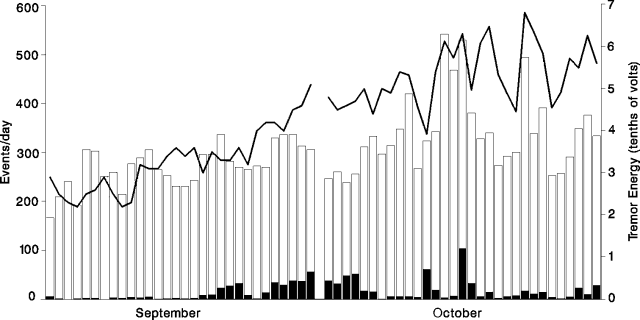Report on Stromboli (Italy) — October 1992
Bulletin of the Global Volcanism Network, vol. 17, no. 10 (October 1992)
Managing Editor: Lindsay McClelland.
Stromboli (Italy) Continuous spatter ejection; occasional vigorous explosions; seismicity increases
Please cite this report as:
Global Volcanism Program, 1992. Report on Stromboli (Italy) (McClelland, L., ed.). Bulletin of the Global Volcanism Network, 17:10. Smithsonian Institution. https://doi.org/10.5479/si.GVP.BGVN199210-211040
Stromboli
Italy
38.789°N, 15.213°E; summit elev. 924 m
All times are local (unless otherwise noted)
Fieldwork during the third week in October revealed that eruptive activity was mainly concentrated in crater 1, in the NE part of the summit area. Spatter ejection was nearly continuous and explosions were frequent from C1's NE vent. Rare strong explosions from vent 5 of C3 (SW summit area) fed black plumes about 200 m high. Strong noisy degassing occurred from C2, with some spatter emission from vents that had developed from pre-existing fissures. C1 had been partially filled with debris and the spatter cone in C3 destroyed.
Tremor energy and the number of earthquakes increased steadily in September and October (figure 27). The strongest activity was recorded 14-16 October with > 20 events/hour (20% with ground velocities exceeding 100 mm/s).
Geological Summary. Spectacular incandescent nighttime explosions at Stromboli have long attracted visitors to the "Lighthouse of the Mediterranean" in the NE Aeolian Islands. This volcano has lent its name to the frequent mild explosive activity that has characterized its eruptions throughout much of historical time. The small island is the emergent summit of a volcano that grew in two main eruptive cycles, the last of which formed the western portion of the island. The Neostromboli eruptive period took place between about 13,000 and 5,000 years ago. The active summit vents are located at the head of the Sciara del Fuoco, a prominent scarp that formed about 5,000 years ago due to a series of slope failures which extends to below sea level. The modern volcano has been constructed within this scarp, which funnels pyroclastic ejecta and lava flows to the NW. Essentially continuous mild Strombolian explosions, sometimes accompanied by lava flows, have been recorded for more than a millennium.
Information Contacts: M. Riuscetti, Univ di Udine.


